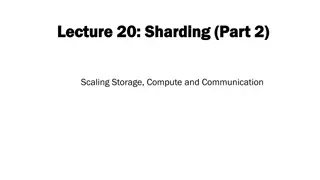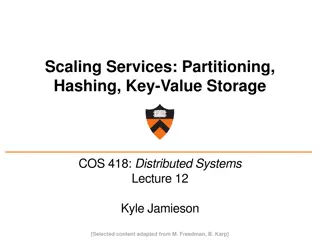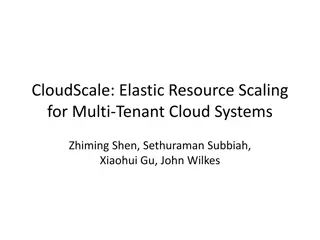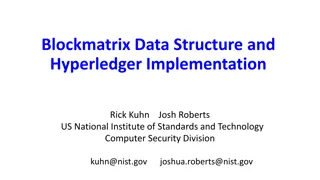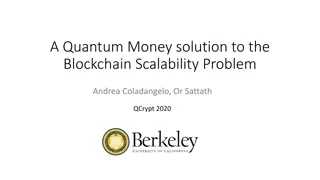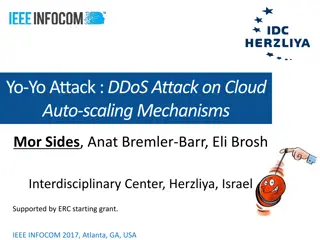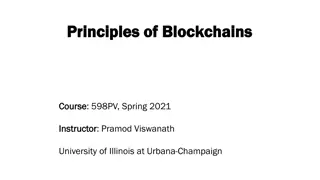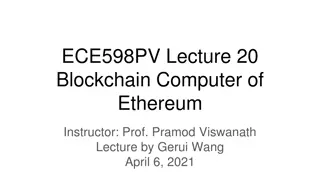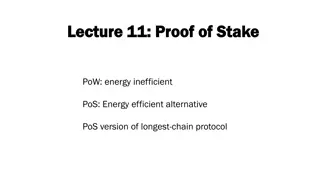Advancements in Blockchain Scaling Techniques
Explore the innovative approach of OHIE in simplifying and enhancing blockchain scaling, increasing throughput, ensuring security, and improving decentralization. OHIE's parallel instances of Nakamoto consensus offer significant performance improvements, paving the way for higher transactions per second and reduced confirmation latency in blockchain networks.
Download Presentation

Please find below an Image/Link to download the presentation.
The content on the website is provided AS IS for your information and personal use only. It may not be sold, licensed, or shared on other websites without obtaining consent from the author. Download presentation by click this link. If you encounter any issues during the download, it is possible that the publisher has removed the file from their server.
E N D
Presentation Transcript
OHIE: Blockchain Scaling Made Simple Haifeng Yu, Ivica Nikolic, Ruomu Hou, Prateek Saxena National University of Singapore
Throughput of blockchains Modern blockchains thousands of transactions/second Bitcoin (Nakamoto Consensus) Some example modern Blockchain transactions/second (observed in experiments) ~2,000 7 RSCoin (NDSS 16) ByzCoin (USENIX Sec 16) ~1,000 Algorand (SOSP 17) Omniledger (SP 18) RapidChain (CCS 18) ~1,000 ~3,000 ~8,000 transactions/second OHIE: Blockchain Scaling Made Simple Haifeng Yu, Ivica Nikolic, Ruomu Hou, Prateek Saxena 2/19
Simplicity is important Nakamoto consensus is remarkably simple Can be fully described in a few dozens of lines of pseudo-code Simplicity is always good! More reliable implementation Easy re-parametrization in different deployments Formal proofs and cross validations Critical! Consensus protocols are notoriously difficult to analyze in the presence of byzantine failures OHIE: Blockchain Scaling Made Simple Haifeng Yu, Ivica Nikolic, Ruomu Hou, Prateek Saxena 3/19
Can we have both? Simplicityof Nakamoto consensus Throughputof state-of-the-art blockchain protocols and OHIE: Blockchain Scaling Made Simple Haifeng Yu, Ivica Nikolic, Ruomu Hou, Prateek Saxena 4/19
Our contribution: OHIE OHIE composes many parallel instances of Nakamoto consensus E.g. 1000x instances -> 1000x throughput Permissionless, PoW Security proof by reduction to Nakamoto Consensus* Provably secure with ? < 0.5 *: Analysis of the blockchain protocol in asynchronous networks. PASS, R.et al.(EUROCRYPT17) A Better Method to analyze Blockchain Consistency. KIFFER, L. et al. (CCS18) OHIE: Blockchain Scaling Made Simple Haifeng Yu, Ivica Nikolic, Ruomu Hou, Prateek Saxena 5/19
OHIE: Performance Experiment on up to 50,000 nodes Throughput Scales linearly with available bandwidth E.g. 20Mbps bw/node -> 10 Mbps throughput (2,500 transactions/sec) Confirmation latency Below 10min (Bitcoin: ~60min, Ethereum ~3min) Decentralization factor # Distinct blocks / sec At least an order of magnitude higher than prior blockchains OHIE: Blockchain Scaling Made Simple Haifeng Yu, Ivica Nikolic, Ruomu Hou, Prateek Saxena 6/19
Problem statement Blockchain problem: Node agree on a growing list of blocks Safety: The order is consistent on all the nodes Liveness: Honest blocks are included at a healthy rate . B5 B6 B7 B8 B1 B3 B4 B2 Blockchain Protocol B1 B4 B5 B8 B2 B6 B7 B3 Total ordering leads to: No double-spending State-machine replication Smart contract etc. . Slot 1Slot 2Slot 3Slot 4Slot 5Slot 6 Slot 7Slot 8 Replicated List of Blocks OHIE: Blockchain Scaling Made Simple Haifeng Yu, Ivica Nikolic, Ruomu Hou, Prateek Saxena 7/19
Security model Permissionless, Proof-of-Work Peer-to-peer overlay (for broadcast) Security analysis follows the existing models* *: Analysis of the blockchain protocol in asynchronous networks. PASS, R.et al.(EUROCRYPT17) A Better Method to analyze Blockchain Consistency. KIFFER, L. et al. (CCS18) OHIE: Blockchain Scaling Made Simple Haifeng Yu, Ivica Nikolic, Ruomu Hou, Prateek Saxena 8/19
Mining: Single Nakamoto Consensus instance Nakamoto Consensus Parameters Block size Block propagation delay Expected Inter-block time Byzantine Tolerance* 20KB 2 sec 10 sec ? < 0.43 1 block every 10 seconds 2KB/s throughput Assume system hash power: 260 / 10 sec Valid block hash: 60 leading zeroes (in binary) *: Analysis of the blockchain protocol in asynchronous networks. PASS, R.et al.(EUROCRYPT17) OHIE: Blockchain Scaling Made Simple Haifeng Yu, Ivica Nikolic, Ruomu Hou, Prateek Saxena 9/19
Mining on 1024 instances simultaneously Previously, valid block hash requires 60 leading zeros OHIE instead requires 50 leading zeros with 1024 chains. Another 10 bits of the hash indexes to one of the chains E.g. last 10 bits Not a sharding design For any given chain, the probability of adding a block to it is the same as before Formalized in our reduction OHIE now generated 1024 blocks / 10 seconds 2048KB/sec throughput Instance 0 Instance 1 Instance 2 New Block Instance 1023 Hash Value = 000 000XX .XX0000000010 e.g. Last 10 bits 2 50 leading 0 s OHIE: Blockchain Scaling Made Simple Haifeng Yu, Ivica Nikolic, Ruomu Hou, Prateek Saxena 10/19
How many parallel instances to use? Use as many instances as possible without significantly affecting the propagation delay. Using more parallel instances consumes more bandwidth Experiment: using about half of the bandwidth does not increase propagation delay significantly Propagation Delay (sec) OHIE: Blockchain Scaling Made Simple Haifeng Yu, Ivica Nikolic, Ruomu Hou, Prateek Saxena 11/19
Use a Merkle tree to bind to many blocks How does a block commit to a parent Instance 0 Use Merkle tree to commit to all 1024 frontier blocks simultaneously Tree root included in the block Instance 1 Merkle Tree Tree root Instance 1023 Block Hash Value = 000 000XX .XX0000000001 The last block on the longest chain OHIE: Blockchain Scaling Made Simple Haifeng Yu, Ivica Nikolic, Ruomu Hou, Prateek Saxena 12/19
Ordering blocks on 1 instance Last ? blocks on the longest chain are not confirmed Partially-confirmed blocks OHIE: Blockchain Scaling Made Simple Haifeng Yu, Ivica Nikolic, Ruomu Hou, Prateek Saxena 13/19
Order partially confirmed blocks across instances Goal: Total order on the partially confirmed blocks E.g. 3 instances Instance 0 baseline design: loop over instances and take the lowest indexed partially confirmed block each time Stops when an instance runs out of partially confirmed blocks 1 4 7 Instance 1 2 5 Instance 2 3 6 Partially-confirmed blocks Fully-confirmed blocks OHIE: Blockchain Scaling Made Simple Haifeng Yu, Ivica Nikolic, Ruomu Hou, Prateek Saxena 14/19
Problem of the baseline design Chains grow at different speed Although the expected growth rates are the same Fast instances waiting for the slower instances catch up Cause long confirmation delay Delay can be unbounded E.g. baseline ordering Instance 0 1 4 7 Instance 1 2 5 Instance 2 3 6 Long Confirmation Delay Partially-confirmed blocks Fully-confirmed blocks OHIE: Blockchain Scaling Made Simple Haifeng Yu, Ivica Nikolic, Ruomu Hou, Prateek Saxena 15/19
Dealing with slow instances Solution: Give a larger virtual size to blocks on slower instances so it catches up immediately View a block on slower instances as multiple block worth Choose virtual size that helps to match the fastest instance E.g. Virtual Size Instance 0 9 1 4 7 Instance 1 2 5 Instance 2 10 11 12 3 6 8 Long Confirmation Delay Partially-confirmed blocks Fully-confirmed blocks OHIE: Blockchain Scaling Made Simple Haifeng Yu, Ivica Nikolic, Ruomu Hou, Prateek Saxena 16/19
Assign virtual size in a distributed way Instance no. Virtual length Mining a new Block 1. Commit to all frontier blocks 2. Mine a valid nonce 3. Assign to an instance 4. Miner assigns a virtual size 1 0 4 8 9 10 1 1 2 3 3 6 7 8 2 7 8 5 9 2 10 1 3 4 5 6 7 8 6 11 3 Nonce Hash Value = 000 000XX .XX0000000001 Hash Value = 000 000XX .XX0000000010 Many partially-confirmed blocks awaiting ordering With 3 new blocks mined to instance 0, all these will be fully confirmed Merkle Tree Longest chain virtual length: 3 Chain 2 virtual length: 1 Block virtual size: 3 1 = 2 Tree Root Last 10 bits -> 1 50 leading 0 s V.size=1 V.size=2 Vsize Chain 1 already have the biggest virtual length, assign min size 1 Data New Block Partially-confirmed blocks Fully-confirmed blocks OHIE: Blockchain Scaling Made Simple Haifeng Yu, Ivica Nikolic, Ruomu Hou, Prateek Saxena 17/19
Virtual sizes chosen by the adversary Virtual size is determined by the miner Adversary has freedom in choosing the virtual size: Choose a small value: It will not help the slow instance to catch up , but it s okay because later honest blocks will still help Choose a big value: prevented by requiring a pointer to the head of the longest chain OHIE: Blockchain Scaling Made Simple Haifeng Yu, Ivica Nikolic, Ruomu Hou, Prateek Saxena 18/19
Conclusions OHIE: A simple blockchain protocol with state-of-the-art throughput Composes as many Nakamoto consensus instances as permitted by available bandwidth Ensure that the adversary splits its power evenly across all the chains Orders blocks across multiple chains into a total order Admits a modular security proof based on reduction from Nakamoto consensus details in paper Safety and liveness proofs Chain consistency, chain growth, chain quality proofs OHIE: Blockchain Scaling Made Simple Haifeng Yu, Ivica Nikolic, Ruomu Hou, Prateek Saxena 19/19




